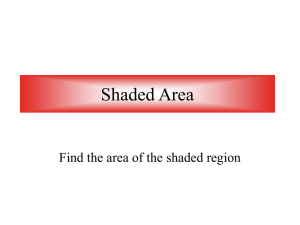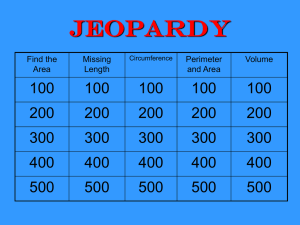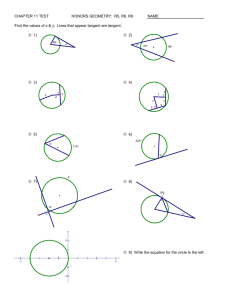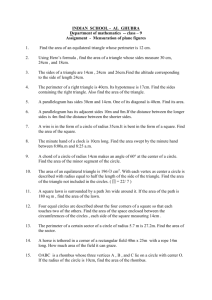Presentation
advertisement
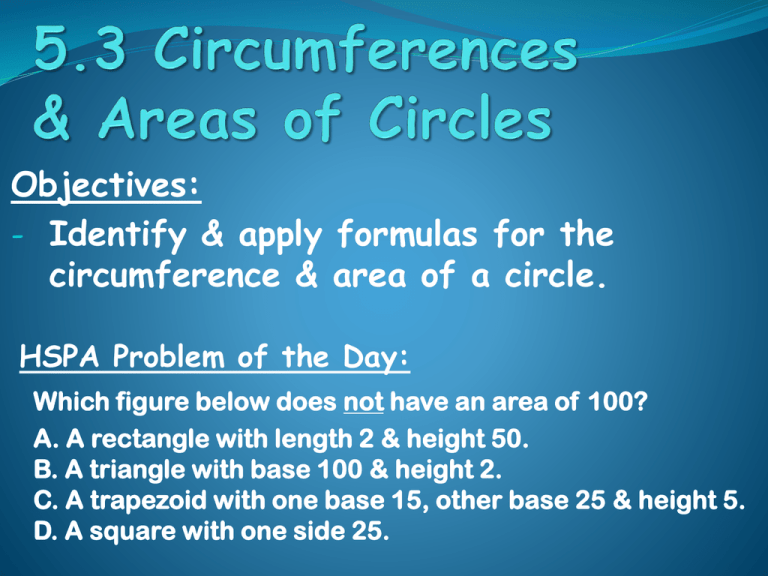
Objectives: - Identify & apply formulas for the circumference & area of a circle. HSPA Problem of the Day: Which figure below does not have an area of 100? A. A rectangle with length 2 & height 50. B. A triangle with base 100 & height 2. C. A trapezoid with one base 15, other base 25 & height 5. D. A square with one side 25. Warm-Up: Circle: The set of all points in a plane that are the equidistant from a given point known as the center of the circle. Center of a Circle: The point inside a circle that is equidistant from all points on the circle. Radius: A segment that connects the center of a circle with a point on the circle [one-half the diameter of the circle] Diameter: A chord that passes through the center of a circle; twice the length of the radius of the circle. Circumference: The distance around a circle. 𝑪 = π𝒅 𝒅 = 𝟐𝒓 Area of a Circle: 𝑨= 𝟐 π𝒓 Find the radius of the circle; leave answers in terms of π 1. C = 12 2. C = 50π 3. C = 3 Find the radius of the circle; leave answers in terms of π 1. A = 36π 2. A = 46 3. A = 314 Find the radius of the circle; leave answers in terms of π 1. C = 2∏ 2. C = 24 3. A = 20π 4. A = 628 Find the area of the shaded region. Find the area of the green shaded region. Find the area of the shaded region. Find the area of the shaded region. EXIT TICKET Homework: Practice worksheet; skip 7 & 11 Objectives: Develop strategies to find the perimeter & area to unique polygons. Warm-Up - Collins Writing Type 1: Describe how you would find the perimeter of the given figure. _________________________ _________________________ _________________________ _________________________ _________________________ _________________________ _________________________ 10 10 Find the perimeter & area of the figure. 10 10 HSPA Problems of the Day: Figure-B: One side of the square is 12 centimeters. What is the area of the shaded region? A. 144 square units C. 113 square units B. 31 square units D. 75 square units Figure-A: Diameter of large circle = 14, diameter of small circle = 10. What is the approximate area of the shaded region? A. 232 square units C. 75 square units B.154 square units D. 6 square units HSPA Problems of the Day: Figure-C: The square measures 6 feet on each side and its diameter measure approximately 8.5 feet. What is the approximate area of the shaded region? A. 4-5 𝑓𝑡 2 B. 15-16 𝑓𝑡 2 C. 6-8 𝑓𝑡 2 D. 20-21 𝑓𝑡 2 Figure-D: The rectangle has a base of 5 inches and is 8 inches tall. What is the area of the shaded region? A. 20 𝑖𝑛 B. 10 𝑖𝑛2 C. 40 𝑖𝑛2 D. 20 𝑖𝑛2 Find the perimeter & area of the shaded region. Find the perimeter & area of the figure. 7 12 15 Find the perimeter & area of the figure. 6 15 24 Find the area of the figure. 26 8 32 Find the area of the shaded sector. 1100 12in Find the area of the shaded sector. 370 19m Find the area of the shaded sector. 14cm 2600 Homework: Practice worksheet Objectives: Use formulas for are to identify the missing length of a given polygon. Warm-Up: Without lifting your pencil, can you connect all of the dots with four straight lines? The height of a parallelogram is 8 feet more that its base. If the area of the parallelogram is 48 square feet find its base and height. The height of a parallelogram is four times its base. If the area of the parallelogram is 256 square centimeters. Find its base and height. The base of a triangle is 6 times its height. The area of the triangle is 147 square inches. Find the base and the height of the triangle. The height of a triangle is twice its base. If the area of the triangle is 196 square millimeters, find the base and height. A trapezoid has base lengths of 9 feet and 16 feet, with an area of 225 square feet. What is the height of the trapezoid? A trapezoid has a height of 6 meters, a base of 24 meters, and an area of 168 square meters. What is the length of the other base? Homework: Practice worksheet Find the probability of a dart landing in each area: (LEAVE ANSWERS IN EXACT FORM) P(red): P(blue): P(yellow): P(brown):
